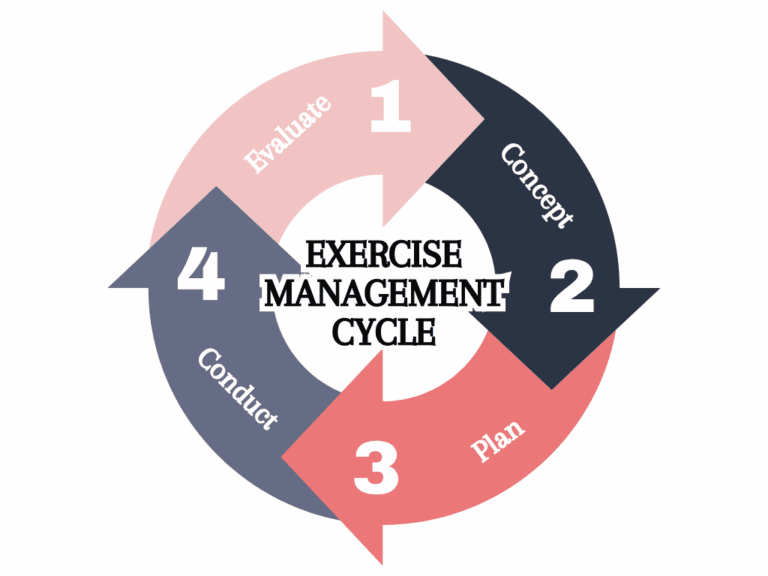Emergency Preparedness Drills & Emergency Management Exercises
Tailored Emergency Management & Stimulation Exercises
Emergency and Crisis exercises help to prepare an organisation to be ready to respond to any emergency or crisis event. Exercising is critical to the preparedness phase of the emergency management cycle as it allows team members to practice discharging their duties without real world consequences and tests the appropriateness of the processes and procedures, they have available to them.
At Resilient Services, we specialise in delivering practical, challenging, yet solvable emergency and crisis exercises. As one of the leading emergency management consulting companies, we take a collaborative approach to exercise planning. By working closely with your organisation’s emergency preparedness consultant or subject matter experts, we ensure exercises are relevant, plausible, and engaging. Whether you need a discussion-based exercise, live field deployment, or anything in between, we deliver tailored solutions to meet your needs.
What is an Emergency Management & Stimulation Exercise?
An exercise is a controlled, objective-driven activity used for testing, practising or valuating processes or capabilities.
An exercise can be as simple as a planning group discussing an emergency plan or as complex as a major multi-agency event involving several organisations and
participants.*
*SOURCE: Handbook 3 of the Australian Institute for Disaster Resilience (AIDR) series, Managing Exercises.

Resilient Services remove the hassle of emergency exercise delivery
We will create all documentation and undertake all exercise planning, right through to facilitating the exercise for your organisation and providing an exercise report inclusive of recommendations to satisfy regulatory responsibilities.
A Resilient Services emergency exercise generally includes three to four hours of active simulation; however, full or multi-day exercises are available as well, with 24/7 observation provided, and all exercises conclude with a hot debrief of participants.
We design and manage our emergency exercises in accordance with Handbook 3 of the Australian Institute for Disaster Resilience (AIDR) series, Managing Exercises.
To discuss your exercise needs, please get in touch with us today.
The Phases of Emergency Exercises:

The effectiveness of an emergency exercise and simulation drill relies on using a structured approach. The exercise management model outlines the key phases involved in designing, planning, delivering, and evaluating a successful exercise.
The Benefits of Realistic Emergency Preparedness Exercises & Stimulation Drills:
Improved Preparedness
Organisations that participate in realistic simulations are far better equipped to respond effectively when real emergencies arise. By exposing staff to challenging scenarios in a controlled environment, these exercises build familiarity and confidence in executing emergency plans. As a result, teams are more likely to act decisively and maintain composure during actual crises, reducing the potential for confusion and error.
Enhanced Teamwork
Exercises provide an invaluable opportunity for teams to practice communication, coordination, and decision-making under pressure. When individuals from different departments come together to work through a scenario, they develop a stronger understanding of each other’s roles and how their actions interconnect. This shared experience fosters trust and collaboration, which are essential for an effective emergency response.
Identifying Gaps
Running regular exercises helps organisations uncover gaps or weaknesses in their emergency plans and procedures before a crisis occurs. Whether it is outdated contact lists, unclear responsibilities, or insufficient resources, identifying these issues during practice means they can be corrected proactively. This continuous improvement cycle strengthens overall resilience and ensures readiness for a broad range of incidents.
Compliance and Assurance
Participating in exercises demonstrates due diligence and supports compliance with relevant regulatory requirements and industry standards. It provides evidence to stakeholders—such as clients, regulators, and insurers—that the organisation is committed to preparedness and risk management. This not only builds confidence in the organisation’s ability to protect people and assets but can also assist in negotiating more favourable insurance premiums by proving that robust mitigation measures are in place.
Industries that are offered Emergency Exercises
Resilient Services provides emergency exercises to clients across New Zealand and Australia in metropolitan cities such as Melbourne, Perth, Sydney, Adelaide, and Brisbane. These industries include, but are not limited to:
Book your FREE 30 minutes resilience assessment now
- Discuss your challenge
- Walk away with the next steps
- You will get your situation evaluated
What our clients are saying
“Business continuity plan is comprehensive and flawless.”
Top 4 Australian
Accounting Firm 2021

